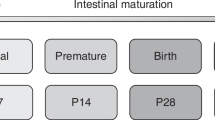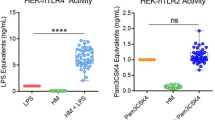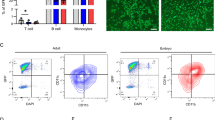Abstract
The intestinal epithelium is an active participant in the mucosal immune response against luminal pathogens. Microorganisms and their cell wall products, i.e. lipopolysaccharide (LPS), can stimulate the enterocyte to produce an innate immune response with the increased production of IL-8 via an activation of the transcription factor NFκB. The innate response mechanism, however, has not been understood until the recent description of a family of human toll-like receptors (hTLR) on immune cells that interact with LPS and modulate the IL-8 response via an intracellular signal transduction pathway similar to that of the IL-1 receptor family. Accordingly, in this study we have sought to determine the constitutive and regulated expression of hTLR on a nonmalignant human fetal primary small intestinal cell line (H4 cells) and on small intestinal samples of ileum from human fetuses (age 18–21 wk). Specimens were examined by reverse-transcription PCR, Western blot analysis, and immunofluorescence for hTLR2 and hTLR4 mRNA and protein and to determine whether their expression was regulated by LPS or by an endogenous inflammatory stimulus, IL-1β. hTLR2 and hTLR4 were expressed constitutively on H4 cells and on human fetal small intestinal enterocytes, predominantly on the basolateral surface of crypt enterocytes. Inflammatory stimuli appeared to regulate hTLR transcription (IL-1β increased both hTLR2 and hTLR4 whereas LPS decreased hTLR4) and possibly translation (qualitative observations). The presence of hTLR on human fetal enterocyte suggests a mechanism for the innate immune response to pathogens and could provide the basis for further study of the accentuated inflammatory response in age-dependent gastrointestinal diseases such as necrotizing enterocolitis.
Similar content being viewed by others
Log in or create a free account to read this content
Gain free access to this article, as well as selected content from this journal and more on nature.com
or
Abbreviations
- hTLR:
-
human toll-like receptors
- H4 cells:
-
human nonmalignant fetal enterocyte cell line
- THP-1:
-
human monocyte cell line
- PAMP:
-
pathogen-associated molecular pattern
- PRR:
-
pattern recognition receptors
References
Sanderson IR, Walker WA 1999 Mucosal barrier: an overview. In: Ogra PL, Mestecky J, Lamm ME, Strober W, Bienenstock J, McGhee JR (eds) Handbook of Mucosal Immunology. Academic Press, New York, pp 5–17.
Bloom PD, Boedecker EC 1996 Mucosal immune responses to intestinal bacterial pathogens. Semin Gastrointest Dis 7: 151–166
Hromockyj AE, Falkow S 1999 Interactions of bacteria with the gut epithelium. In: Blaser MJ, Smith PD, Ravdin JI, Greenberg HB, Guerrant RL (eds) Infections of the Gastrointestinal Tract. Raven Press, New York, pp 603–615.
Aderen A, Ulevitch RJ 2000 Toll-like receptors in the induction of the innate immune response. Nature 406: 782–787
Stadnyk AW 1994 Cytokine production by epithelial cells. FASEB J 8: 1041–1047
Eckkmann L, Jung HC, Schurer-Maly C, Panja A, Morzycka-Wrobleska E, Kagnoff MF 1993 Differential cytokine expression by human intestinal epithelial cell lines: regulated expression of interleukin-8. Gastroenterology 105: 1689–1697
Kopp EB, Medzhitov R 1999 The toll-receptor family and control of innate immunity. Curr Opin Immunol 11: 13–19
Medzhitov R, Janeway C 2000 Innate immunity. N Engl J Med 343: 338–344
Anderson KV 2000 Toll signaling pathways in the innate immune response. Curr Opin Immunol 12: 13–19
Medzhitov R, Preston-Hurlburt P, Janeway CA 1997 A human homologue of the Drosophila Toll protein signals activation of adaptive immunity. Nature 388: 394–397
Rock FL, Hardman G, Timans JC, Kastelein RA, Bazan JF 1998 A family of human receptors structurally related to Drosophila Toll. Proc Natl Acad Sci U S A 95: 588–593
Lien E, Sellati TJ, Yoshimura A, Flo TH, Rawadi G, Finberg RW, Ca JD, Espevik T, Ingalls RR, Radolf JD, Golenbock DT 1999 Toll-like receptor 2 functions as a pattern recognition receptor for diverse bacterial products. J Biol Chem 274: 33419–33425
Chuang TH, Ulevitch RJ 2000 Cloning and characterization of a sub-family of human toll-like receptors: hTRL7, hTLR8 and hTLR9. Eur Cytokine Netw 11: 372–378
Takeuchi O, Kawai T, Sanjo H, Copeland NG, Gilbert DJ, Jenkins NA, Takeda K, Akira S 1999 TLR6: a novel member of an expanding Toll-like receptor family. Gene 23: 59–65
Yoshimura A, Lien E, Ingalls RR, Tuomanen E, Dziarski R, Golenbock DT 1999 Cutting edge recognition of Gram positive bacterial cell wall components by the innate immune system occurs via Toll-like receptors 2. J Immunol 163: 1–5
Chow JC, Young DW, Golenbock DT, Christ WJ, Gusovsky SA 1999 Toll-like receptor-4 mediates lipopolysaccharide-induced signal transduction. J Biol Chem 274: 10689–10692
Jobin C, Sartor BR 2000 The IkB/NF-kB system: a key determinant of mucosal inflammation and protection. Am J Physiol 278: C451–C462
Cario E, Rosenberg IM, Brandwein SL, Beck PL, Reinecker HC, Podolsky DK 2000 Lipopolysaccharide activates distinct signaling pathways in intestinal epithelial cell lines expressing Toll-like receptors. J Immunol 164: 966–972
Nanthakumar N, Fusunyan RD, Sanderson IR, Walker WA 2000 Inflammation in the developing human intestine: a possible pathophysiologic basis for necrotizing enterocolitis. Proc Natl Acad Sci U S A 97: 6043–6048
Sanderson IR, Ezzell RM, Kedinger M, Erlanger M, Xu Z, Pringault E, Leon-Robine S, Louvard D, Walker WA 1996 Human fetal enterocytes in vitro: modulation of the phenotype extracellular matrix. Proc Natl Acad Sci U S A 93: 7717–7722
Zhang FX, Kirschning CJ, Mancinelli R, Xu XP, Jin YP, Faure E, Mantovani A, Rothe M, Muzio M, Arditi M 1999 Bacterial lipopolysaccharide activates nuclear factor-κB signaling mediators in cultured human dermal endothelial cells and mononuclear phagocytes. J Biol Chem 274: 7611–7614
McCormick BA, Gerwirtz AT, Madara JL 1998 Epithelial cross-talk with bacteria and immune cells. Curr Opin Gastroenterol 14: 492–497
Acknowledgements
The authors wish to thank Dr. Lei Lu for her technical assistance with the immunofluorescence studies.
Author information
Authors and Affiliations
Corresponding author
Additional information
Supported by National Institute of Health grants K08 DK02481, P01 DK33506, R37 HD12437, and R01 HD31852, and a grant from Wyeth Nutritionals, Inc.
Rights and permissions
About this article
Cite this article
Fusunyan, R., Nanthakumar, N., Baldeon, M. et al. Evidence for an Innate Immune Response in the Immature Human Intestine: Toll-Like Receptors on Fetal Enterocytes. Pediatr Res 49, 589–593 (2001). https://doi.org/10.1203/00006450-200104000-00023
Received:
Accepted:
Issue date:
DOI: https://doi.org/10.1203/00006450-200104000-00023
This article is cited by
-
Ontogeny of alkaline phosphatase activity in infant intestines and breast milk
BMC Pediatrics (2019)
-
Recognizing conserved non-canonical localization patterns of toll-like receptors in tissues and across species
Cell and Tissue Research (2018)
-
Human perinatal immunity in physiological conditions and during infection
Molecular and Cellular Pediatrics (2017)
-
Bifidobacterium adolescentis protects against necrotizing enterocolitis and upregulates TOLLIP and SIGIRR in premature neonatal rats
BMC Pediatrics (2017)
-
The middle ear immune defense changes with age
European Archives of Oto-Rhino-Laryngology (2016)



